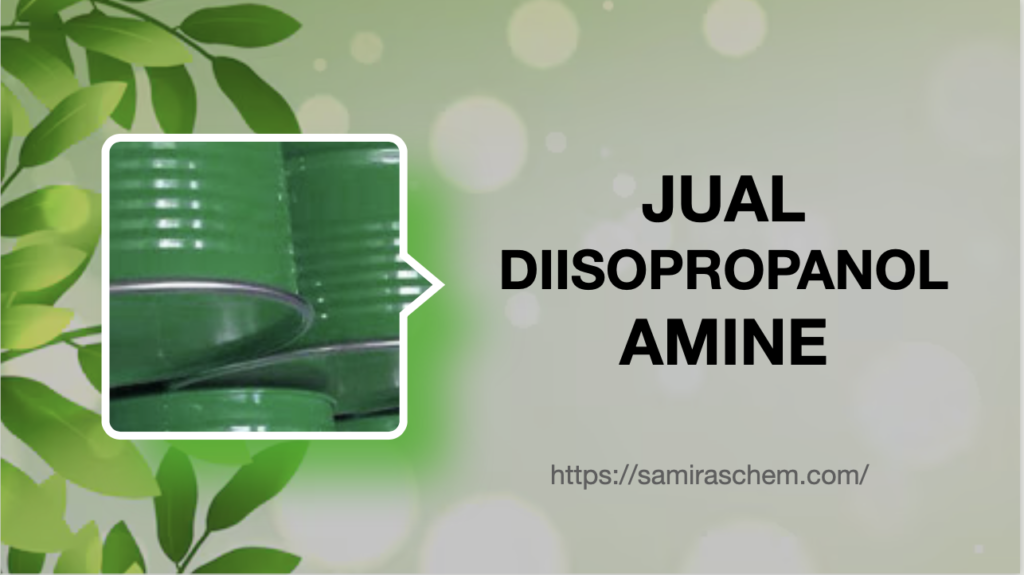Jual Diisopropanolamine
Jual Diisopropanolamine (DIPA), a versatile organic compound, is a secondary amine with the molecular formula C6H15NO2. It is derived from ammonia and isopropanol, making it a member of the alkanolamine family. Structurally, it features two isopropanol groups attached to a central nitrogen atom, which also bears a hydrogen atom. This structure imparts unique chemical and physical properties that find utility in a wide range of industrial, commercial, and even pharmaceutical applications.
Diisopropanolamine is known for its effective role as a neutralizing agent, buffer, and chemical intermediate. It is a colorless to pale yellow viscous liquid with a mild ammonia-like odor. Its versatility stems from its bifunctional nature, possessing both alcohol and amine functionalities. These attributes enable DIPA to act as a reactive agent in various formulations and processes.
Chemical Properties Jual Diisopropanolamine
The distinctive properties of DIPA are attributed to its chemical structure. Key chemical attributes include:
-
- Molecular Weight: Approximately 133.19 g/mol.
- Boiling Point: Around 247°C (477°F).
- Melting Point: 43–46°C (solidifies upon cooling).
- Density: 0.98 g/cm³ at 25°C.
- Solubility: Highly soluble in water and many organic solvents such as ethanol and acetone.
Jual Diisopropanolamine is a weak base due to its amine group and can react with acids to form salts. Its hydroxyl groups contribute to its polarity and ability to form hydrogen bonds, which is crucial for its role as a solvent and reactant in various chemical systems.
Industrial Production of Diisopropanolamine
Jual Diisopropanolamine is typically produced through the reaction of ammonia with propylene oxide under controlled conditions. The process can be summarized as follows:
-
- Raw Materials: Ammonia and propylene oxide.
- Reaction:NH3+2 C3H6O→C6H15NO2
- Separation and Purification: The product mixture undergoes distillation and filtration to isolate and purify DIPA.
The production process may also yield other alkanolamines such as mono- and triisopropanolamine, which can be separated based on their boiling points.
Applications of Diisopropanolamine
The multifunctional properties of Diisopropanolamine make it indispensable across various industries. Its key applications include:
-
- Gas Sweetening:
- DIPA is widely used in the oil and gas industry for the removal of acidic gases like hydrogen sulfide (H₂S) and carbon dioxide (CO₂) from natural gas streams.
- This process, known as gas sweetening, utilizes DIPA’s amine group to chemically bind with acidic components, improving gas quality.
- Personal Care Products:
- It serves as a pH adjuster and emulsifier in shampoos, soaps, and lotions.
- DIPA enhances the stability of formulations, ensuring consistent product performance.
- Metalworking Fluids:
- DIPA acts as a corrosion inhibitor and emulsifier in lubricants and cutting fluids used in machining processes.
- Agriculture:
- In the agricultural sector, Diisopropanolamine is employed as an intermediate in the production of herbicides and pesticides.
- It contributes to the formulation of compounds that effectively control weeds and pests.
- Paints and Coatings:
- DIPA functions as a neutralizer and dispersing agent, improving the stability and application properties of paints and coatings.
- Detergents and Cleaners:
- In cleaning products, DIPA enhances cleaning efficiency by adjusting pH and acting as a surfactant.
- Pharmaceuticals:
- Although less common, DIPA can be used as a chemical intermediate in the synthesis of certain pharmaceuticals.
- Gas Sweetening:
Benefits and Advantages
-
- Versatility: DIPA’s dual functional groups allow it to participate in diverse chemical reactions.
- Cost-Effectiveness: It is relatively inexpensive to produce and widely available, making it a practical choice for various industries.
- Environmentally Friendly: Compared to some alternatives, DIPA is less volatile and has a lower toxicity profile.
Safety and Handling
Jual Diisopropanolamine is relatively safe when handled correctly, precautions are necessary due to its potential health and environmental effects. Key safety considerations include:
-
- Health Hazards:
- Inhalation: Vapors or aerosols can cause respiratory irritation.
- Skin Contact: Prolonged exposure may lead to irritation or sensitization.
- Eye Contact: DIPA can cause significant irritation and discomfort.
- Ingestion: Accidental ingestion may result in nausea and gastrointestinal distress.
- Environmental Impact:
- It is biodegradable but should be handled to prevent contamination of water sources due to its potential to alter pH.
- Personal Protective Equipment (PPE):
- Use gloves, goggles, and appropriate respiratory protection when handling DIPA in industrial settings.
- Storage:
- Store in a cool, dry, and well-ventilated area away from oxidizing agents and acids.
- Health Hazards:
Challenges in Using Diisopropanolamine
-
- Corrosion: Despite its use as a corrosion inhibitor, Diisopropanolamine itself can corrode certain metals under specific conditions.
- Reactivity: DIPA reacts with strong acids and oxidizers, necessitating controlled handling.
- Regulatory Compliance: Industries using DIPA must adhere to local and international safety standards, including classification and labeling regulations.
Future Trends and Innovations Jual Diisopropanolamine
-
- Sustainable Production:
- Efforts are ongoing to develop greener synthesis methods for DIPA, reducing reliance on fossil fuel-based raw materials.
- Enhanced Formulations:
- Research is focused on incorporating DIPA into advanced formulations for more effective performance in coatings, detergents, and pharmaceuticals.
- Applications in Renewable Energy:
- DIPA’s role in gas sweetening is expected to expand into carbon capture and storage (CCS) systems, supporting climate change mitigation efforts.
- Sustainable Production:
PT. Samiraschem Indonesia is Reliable Supplier and Distributor Diisopropanolamine with High Quality Product and Good Price. We are Serving and Delivered Area such Jakarta Bandung Semarang Jogja Surabaya Medan and Batam
Jual Diisopropanolamine is a vital chemical with a broad spectrum of applications, ranging from industrial processes to consumer goods. Its unique combination of chemical properties—amphiphilicity, reactivity, and stability—ensures its continued relevance in various fields. However, its handling requires adherence to safety protocols to mitigate potential risks. Future advancements in DIPA production and applications are poised to enhance its sustainability and utility, aligning with global trends in environmental responsibility and technological innovation.
